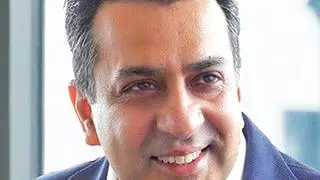Servion Global Solutions is a pioneer in customer interaction management or simply put providing interactive voice response (IVR) systems.
With over 600 customers and 1,000 installations in over 60 countries, its products and solutions handle in over 7 billion voice, fax, Web and e-mail interactions a year.
The Chennai-based company has been in the IVR industry for over 15 years now, and focussed on the Avaya (networking company) platform. However, in the last three to four years, it has created a niche for itself in the Customer Interaction Management space.
During this transition, the company spent nearly Rs 70 crore on its brand, moving to new premises to create better infrastructure for its clients and changed the logo.
“We were silent for nearly two years but we have come out of it, and are now on a growth mode,” said Mr K. Balakrishnan, Managing Director & Chief Executive Officer, Servion.
In an interview with Business Line , he shares his perspective on the industry and the company's transition.
You have been in the industry for nearly 15 years. It took so long to stabilise?
Till four years ago, we were known only as a company specialising in IVR and working on the Avaya platform to set up contact centres for banks and telecom service providers. It was based on fixed cost and fixed time. We had big brands, good visibility and were considered as leaders in the sector. We had over 1,000 customers. However, every year, our revenue remained flat at around Rs 50 crore and growth was struggling.
Why were you struggling?
We were selling solutions to banks and it was on a capex model. A number of banks were given licences and we grew fast. After that, no new bank came in while the existing players had already made the investment, they did not buy our solutions. There was no recurring revenue.
How did the change happen?
Four years ago, we realised that our model was not going to take us anywhere and repositioned ourselves. With over 1,000 installations, we had huge amount of experience but no opportunity to exploit on that. We did three things. First, we looked at more clients giving us long-term recurring revenue and not just fixed time projects. Second, we should be seen as a solution provider to solve day-to-day customer interaction problems rather than someone who just writes an IVR software code. Third, we wanted to be a lot more broad based and not just restrict with Avaya. We partnered with Nortel and Cisco. The key value added we brought was our ability to understand the problem in CIM space and build solutions. We got out of commodities business that where less profitable. We also built a strong consulting team and created lot of consulting IP, which today, are going through patent process.
What's your competency now?
If a customer comes to a company, it could be through voice, email or chat, how to handle the call in the most optimum way. That's our core competency today.
Could you give an example?
A person calls the XYZ bank. From the bank's perspective, there are three drivers on that call. One, what the bank earns out of that call. Second, how much the bank spends to handle that call and third is the whole space of customer experience. We told clients that we will handle the calls from these three perspectives in the most optimum way.
Someone could be a premier customer, so that bank wanted to handle in a different way. Somebody could be a commodity customer for volume. Somebody may be calling repeatedly due to urgency. We can prioritise accordingly.
How is competition?
We used to compete with a number of companies smaller than us. Then, we were the biggest. We used to have large software facilities and our cost structure was always under pressure. But today we compete with top system integrators like Wipro, IBM and HP.
However, we have become hugely unique and become stronger in the CIM space. Three years ago, we said long term – multi-year contracts - should be 50 per cent our revenue. Today, it is 55 per cent. We want to hold it there for fresh orders to come in.
What was the revenue?
We ended last financial year with $35 million in revenue. We will continue to grow in that rate for the next few years. Our typical engagement was Rs 50 lakh or $100,000. We should go and build a $1 million accounts. This year, we closed 10 $1-million clients with whom we will be deeply involved, our consulting will be involved. In India, Asia Pacific and Middle East, our customers are mostly banks. While in the US it is a lot more broad-based, including sectors like pharma or automobile. Our customers include Citi Bank, Tata Teleservices, ANZ, HDFC and SunDirect.
What do your analytics team do?
We have access to huge amount of customer data on IVR. It is all lying there dead. No one sees. So, we have a huge analytic consulting practice, which keeps pulling data consisting of million and millions of from the IVR and keeping looking at patterns like why, what sort of problems customers are having; for what purpose they are calling and so on. Then, we go back to the customer on how to optimise the call to make it different, to speed up the process. We look at it 360 degrees.
How much of the calls go to live agents?
It could be 40-50 per cent, and it could low as 20 per cent. It depends on the focus. If a premier customer is calling a bank, they may like a live agent to handle. In some cases, the call centres focuses on up selling and cross selling, and it is more of a call generator. In this case, automation will be less. In the Indian telecom industry, it has gone to as high as 70 per cent.
What's the saving using IVR?
A call typically costs 20 paise on IVR while an agent will cost Rs 4-5 per call. So, a call completed in an IVR is 30-40 times cheaper than a call that goes to agents. If you automate, it is a huge saving for companies, and that's why everybody is going for it.
Despite avenues like the Internet being used to find out balances, IVR will continue to exist as voice is the preferred choice for people. IVR is not about cutting cost alone but how to retain customers.








Comments
Comments have to be in English, and in full sentences. They cannot be abusive or personal. Please abide by our community guidelines for posting your comments.
We have migrated to a new commenting platform. If you are already a registered user of TheHindu Businessline and logged in, you may continue to engage with our articles. If you do not have an account please register and login to post comments. Users can access their older comments by logging into their accounts on Vuukle.